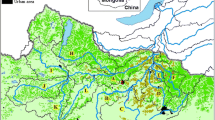Abstract
To determine the appropriate allocation of resources for the future restoration of the abandoned mining district of Kangwon in Korea, identification of the main pollutants and the main sources discharging these pollutants is crucial. Therefore, a 2-year study was undertaken to quantify the amount of pollutants in the Uchen stream (a potential sink for contamination), which runs through the district, and to determine the potential sources of these pollutants, including mine drainage and soil. Arsenic (As) was the main pollutant in mine drainage and soils showing concentrations above the Korean regulated standard levels of 50 μg L−1 and 50 mg kg−1 for water and soil, respectively. In addition, the pollution index (PI) showed that mine drainages were polluted by As to a moderate (2 ≤ PI < 3) or strong (4 ≤ PI < 5) degree. Consequently, As load in mine drainage and soil contributed to increased amounts of As in the stream. The As loads in mine drainages (11 and 587 g month−1 for mine adit 1 and 2, respectively) accounted for only 9% of the total As load to the stream (6,378 g month−1); and the influence of mine drainages on As contents in the stream was more reliant on the total volume of mine drainage generated rather than the As concentration in the mine drainage. Approximately 91% of the As in the stream was derived from the soils within the study area.





Similar content being viewed by others
References
Abreu MM, Matias MJ, Clara M, Magalhães F, Basto MJ (2008) Impacts on water, soil and plants from the abandoned Miguel Vacas copper mine, Portugal. J Geochem Explor 96:161–170
Al-Abed SR, Hageman PL, Jegadeesan G, Madhavan N, Allen D (2006) Comparative evaluation of short-term leach tests for heavy metal release from mineral processing waste. Sci Total Environ 364:14–23
Alloway BJ, Thornton I, Smart GA, Sherlock JC, Quinn MJ (1998) Metal availability. Sci Total Environ 75:41–69
Bhuiyan MAH, Parvez L, Islam MA, Dampare SB, Suzuki S (2010) Heavy metal pollution of coal mime-affected agricultural soils in the northern part of Bangladesh. J Hazard Mater 173:384–392
Christie AB, Brathwaite RL (2003) Hydrothermal alteration in metasedimentary rock-hosted orogenic gold deposits, Reefton goldfield, South Island, New Zealand. Miner Depos 38:87–107
Grosbois C, Schäfer J, Bril H, Blanc G, Bossy A (2009) Deconvolution of trace element (As, Cr, Mo, Th, U) sources and pathways to surface waters of a gold mining-influenced watershed. Sci Total Environ 407:2063–2076
Grosser JR, Hagelgans V, Hentschel T, Priester M (1994) Heavy metals in stream sediments: a gold mining area near Los Andes, Southern Columbia S.A. Ambio 23:46–149
Haffert L, Craw D (2008) Processes of attenuation of dissolved arsenic downstream from historic gold mine sites, New Zealand. Sic Total Environ 405:286–300
Herschy R (1993) The velocity–area method. Flow Meas Instrum 4:7–10
Hewlett L, Craw D, Black A (2005) Comparison of trace element contents of discharges from adjacent coal and gold mines, Reefton, New Zealand. Mar Freshw Res 56:983–995
Kang IS, Ho CH, Lim YK, Lau KM (1999) Principal modes of climatological seasonal and intraseasonal variations of the Asian summer monsoon. Mon Weather Rev 127:322–340
Kim KH, Kim KY, Kim JG, Sa DM, Seo JS, Son BK, Yang J, Em KC, Lee SE, Jung KY, Jung DY, Jung YT, Jung JB, Hyun HN (2006) The soil science. Hyangmoon, Seoul, Republic of Korea
Kim KR, Owens G, Naidu R (2009) Heavy metal distribution, bioaccessibility and phytoavailability in long-term contaminated soils from Lake Macquarie, Australia. Aust J Soil Res 47:166–176
Korea Ministry of Environment (KMoE) (1997a) The soil environment conservation act. Korea Legislation Research Institute, Seoul, Republic of Korea
Korea Ministry of Environment (KMoE) (1997b) The water quality and ecosystem conservation act. Korea Legislation Research Institute, Seoul, Republic of Korea
Korea Ministry of Environment (KMoE) (2003) Investigation of the soil contamination of abandoned metalliferous mines. Final project report. Seoul. Republic of Korea
Korea Ministry of Environment (KMoE) (2009) Investigation of the impact of mine discharge on Han-river watershed. Final project report. Seoul. Republic of Korea
Lee JS, Chon HT (2003) Exposure assessment of heavy metals on abandoned metal mine areas by ingestion of soil, crop plant and groundwater. J Phys IV 107:757–769
Leita L, Mondini C, De Nobili M, Simoni A, Sequi P (1998) Heavy metal content in xylem sap (Vitis vinifera) from mining and smelting areas. Environ Monit Assess 50:189–200
McBride M, Sauvé S, Hendershot W (1997) Solubility control of Cu, Zn, Cd and Pb in contaminated soils. Eur J Soil Sci 48:337–346
Müller G (1969) Index of geoaccumulation in sediments of the Rhine River. Geol J 2:108–118
Nair A, Juwarkar AA, Devotta S (2008) Study of speciation of metals in an industrial sludge and evaluation of metal chelators for their removal. J Hazard Mater 152:545–553
Qu W, Kelderman P (2001) Heavy metal contents in the Delft canal sediments and suspended solids of the River Rhine: multivariate analysis for source tracing. Chemosphere 45:919–925
Rodríguez L, Ruiz E, Alonso-Azcárate J, Rincón J (2009) Heavy metal distribution and chemical speciation in tailings and soils around a Pb–Zn mine in Spain. J Environ Manag 90:1106–1116
Roussel C, Bril H, Fernandez A (2000a) Arsenic speciation: involvement of environmental impact caused by mine wastes. J Environ Qual 29:182–188
Roussel C, Néel C, Bril H (2000b) Minerals controlling arsenic and lead solubility in an abandoned gold mine tailings. Sci Total Environ 263:209–219
Acknowledgments
This research was financially supported by grant as “the Fundamental Investigation on Environment of the Han River” to J.G. Kim from the Korea Ministry of Environment and partly by a grant from Korea University.
Author information
Authors and Affiliations
Corresponding author
Rights and permissions
About this article
Cite this article
Koo, N., Kim, KR., Choi, YJ. et al. Increased As load to the Uchen stream due to mine drainage and soils in the abandoned Kangwon mining district of Korea. Environ Earth Sci 65, 689–697 (2012). https://doi.org/10.1007/s12665-011-1116-7
Received:
Accepted:
Published:
Issue Date:
DOI: https://doi.org/10.1007/s12665-011-1116-7




